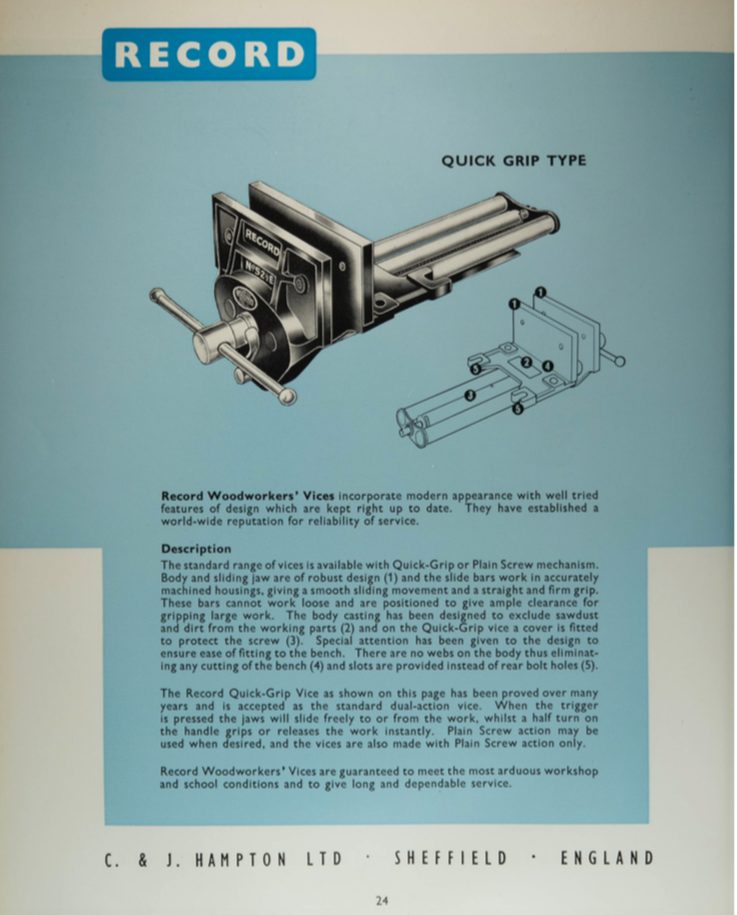Here is a short summary of the history of the Record 52 ½ vice. You can read more about this vice here and information on the other vices mentioned can be found here.
1877-1910
The earliest quick release vices were know as "instantaneous grip" vices.
Wilson Riley and and an unknown inventor working for Smith, Marks & Co working independently applied to patent two different quick-release (QR) vices in 1877. Both inventors were living in Keightley, Yorkshire.
Riley’s invention was purchased by Entwisle and Kenyon and marketed as the Lightening Grip vice. The same design was produced by Massey under license for the US Market.
Smith, Marks & Co handled manufacturing for the other vice design and they were sold by Thomas Syer of London and marketed as the Syer's Standard Instantaneous Grip vice.

Syer's Standard Instantaneous Grip vice
The vices were both successful enough to warrant a glowing write-up in Francis Young’s seminal work Everyman His Own Mechanic (1881).
An important development in quick-release vices came in 1884 when Joseph Parkinson invents a new quick-release mechanism and files for a patent to protect. He calls his new range of vices the ‘Patent Perfect’ range.

Parkinson's 'Perfect' vises
Vices based on his design are still made today. More on Parkinson’s invention here
Around this time WC Toles, an American inventor, patents a new quick-release mechanism and launches the first home grown USA quick-release vice of note. It is of interest because it is one of the earliest vices to use steel rods rather than cast iron sliders. The vice competes with the Massey version of the E&K vice in the US market.
Read more about the Toles vice here and vices made by a their US competitor Wilcox.

W. C. Toles Rapid-acting vice
1910-1930
The first Record vice - 1910
C&J Hampton release their first wood-worker's vice in 1910, a copy of Parkinson’s (which is no longer protected by his patent) and gives their vices the trade name Record.
More about the vice that became the world famous Record 52 ½ can be found here

The original Record wood-worker's vice
1918
C&J Hampton release an improved version, retaining the Parkinson quick release mechanism but incorporating steel rods rather than cast iron sliders. Although they have borrowed the idea of the rods, they take the precaution of registering a design patent and casting the design number into the front of the casting.

Record 52 ½ showing the registered design number
1927
C&J Hampton introduce the ‘screw and nut cover’ (this is a metal cover that extends the length of the screw, preventing sawdust and shavings dropping on the thread). Vices that included the cover were given an ‘A’ post-fix. These models were about 10% more expensive than the standard vices)

Screw and Nut Cover patent
1930s-1940s
1932
C&J Hampton apply to patent a “sawduster excluder plate” (see the plate with the blue and yellow sticker on it in the picture below). At the same time they also introduced a removable housing for the the half nut and changed the position of the spring (moving it from under the half nut to the inside face of the front jaw). Around this time C&J Hampton introduce a new range of bench planes and extended the use of their trade name ‘Record’ to cover these too.

sawdust excluder plate
1935
C&J Hampton’s registered design patent expired in 1933, but it is likely that they continued to use castings with the number embossed on them for some period after that (possibly because they were working through old stock of castings). At some point in the 1930s they introduced a transitional casting with the RD number removed.

transitional casting
1940
Record redesigned the front jaw casting once again, removing the space previously reserved for the RD number. This version of the vice was the pinnacle of Record’s vice designs and remained unchanged until the 1960s.

Record vice design perfected
1960s
The final version of C & J Hampton’s woodworker’s vices that they would produce as an independent company was introduced in 1963. The range included a number of changes that, although billed as improvements, would no doubt have resulted in reduced manufacturing costs.

1963 redesign
today
The current owners of the Record brand (Irvin) continue to make a version of the QR vice, although it is a pale imitation of the versions made in the 30s, 40s and 50s. Countless companies have made copies of the design over the years. Some of the high quality versions are by Parkinson, Toga (Bucks and Hickman), Rededa, Paramo, Marples, Woden. The modern copies (Irvin, Anant, York, Dawn etc), although functional, are made to a comparably low standard to keep the price down.